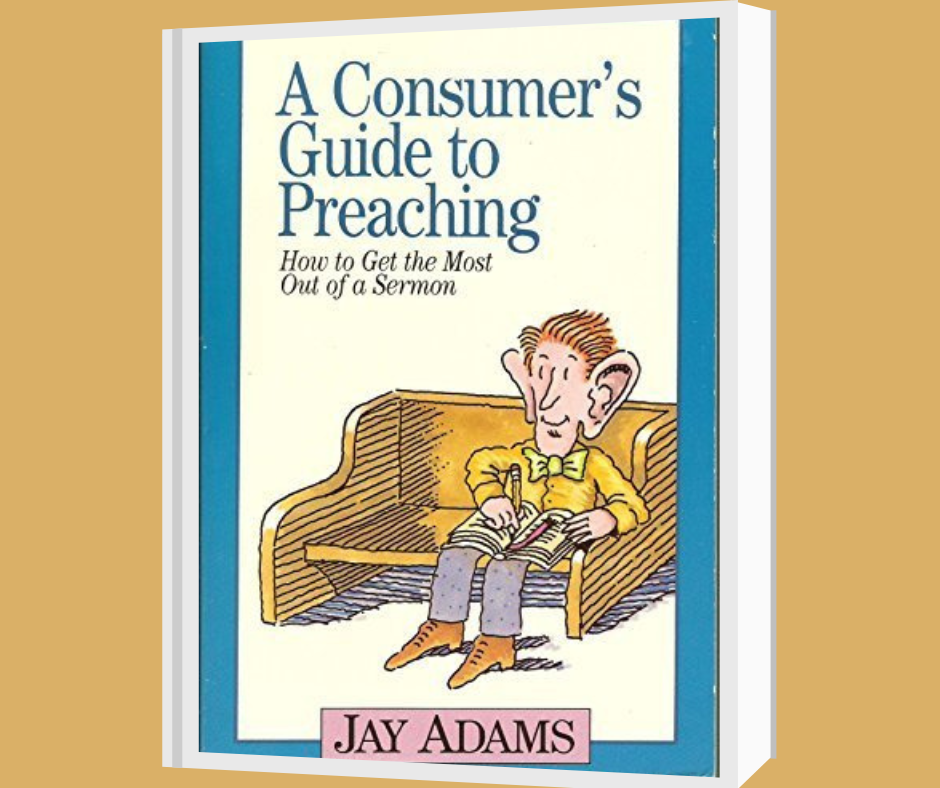Book Reviews
A Consumer’s Guide to Preaching by Jay Adams | Review by Rosa Byler
A Consumer’s Guide to Preaching: How to Get the Most out of a Sermon, by Jay Adams

Every week Christian preachers of various denominations stand behind pulpits and deliver sermons designed to communicate God’s Word to His people. Preaching, “the principal means by which the Holy Spirit promotes spiritual growth” (9), is their calling and responsibility.
Jay Adams has spent most of his years of ministry in teaching preachers to proclaim God’s message more effectively and clearly, but he has concluded that listeners have an obligation as well! When sermons are ineffective, the preacher is not the only one to blame. The duty of the “consumers” is to hear, understand, and apply the sermon—and the Bible actually says more about this than it does about the duty of the preacher. This book is a call to undisciplined hearers everywhere to pick up their study helps and start doing what Adams calls “Berean listening.”
Conversion is the obvious starting point, since the natural man will find the teachings of God “foolishness.” Preparation then begins with such simple basics as adequate sleep and Sunday-morning household organization, progressing to prayer, studying ahead (particularly in a sermon series), and examining our attitudes, expectations and spiritual condition. Adams suggests that not only do we need more in-depth Bible study, we need a “sense of wonder.” When we are amazed at the presence and greatness of God, we will approach the sermon eagerly to find out more about Him.
Once we are seated and actually hearing a sermon, our job is to “work at getting the message” (47). In order to do this, Adams suggests discovering and summarizing in one sentence the central thought of a message. This gives us something to meditate on in the next week, increasing retention and understanding—which includes hearing, properly processing, and storing truth, leading to fruit-bearing. (We may find it helpful to recognize different types of sermons: informative, persuasive, or motivational.)
What about sermons that are truly hard to process--what Martin Luther called “insignificant sermons”? Three types of difficult messages are evaluated: heresy, seeming heresy, and “thin soup.” Adams offers Scriptural procedures for resolution of apparent or outright heresy (some of which are more applicable to churches run by boards or presbyteries). What about consistently poor preaching? Prayer is at the top of a list of helpful suggestions, including financial help for good books or courses in preaching, and concluding with the reminder that Jesus sat under synagogue sermons for thirty years.
All of us are familiar with the noble Bereans, and many Christian schools are named after them with the intention of inspiring students to follow their example. Adams says bluntly that if we do not own and know how to use a good Bible dictionary, a concordance, commentaries, and a cross-reference Bible, we “can hardly be serious about listening.” (77)
After a chapter on possible distractions and how to avoid them, Adams comments on the importance of congregational encouragement, prayer, and enthusiastic listening to the message-bearer. Two chapters cover implementation and what Adams calls “other-directed learning,” lest we think that our own personal development is the highest benefit to be sought in good listening. Listen out of a love for God and a desire to please Him as well as to provoke one another to love and good works!
Adams provides several technical helps for sermon analysis. While not all of us will need this information to improve our own sermon production, he suggests it will be useful in identifying problems within a sermon. This makes it easier to ignore them and focus on the elements that are worthwhile and edifying. (For example, if the content of the sermon is good but the delivery is poor, recognize that and focus on the content. If the content is adequate but poorly organized, take notes and rearrange the order at home—a great way to review and reinforce what you have heard!)
Adams concludes with a very practical exercise in good “listening” and studying techniques: thirty-one “slices” from actual sermons, to give the reader an opportunity to put to use some of the principles he has learned. These excerpts come from the written works of preachers no longer living; they include good and bad preaching, truth and error and even heresy. All are anonymous.
This book will convict most (if not all) of its readers of poor listening habits; you may be accustomed to paying attention and occasionally taking notes, but when was the last time you picked up a study help after a message in an effort to increase your understanding? You will find Adams’ style easy reading, but the content is designed to challenge.
The book assumes some slight differences of ecclesiastical structure from typical Anabaptist practice. Most of us would take issue with Adams’ idea that children should not be present for the sermon until they are old enough to understand. He theorizes that this will cause them to develop poor listening habits as well as prove a distraction to others in the audience and a hindrance to the parents’ absorption of the sermon. (Neh. 8:1-8, where “all who could understand” were gathered to hear the Law, is his foundation for this suggestion.) Certainly, an undisciplined child will hinder parental assimilation of the sermon; this provides another incentive for proper child-training, traditionally an important Anabaptist value.